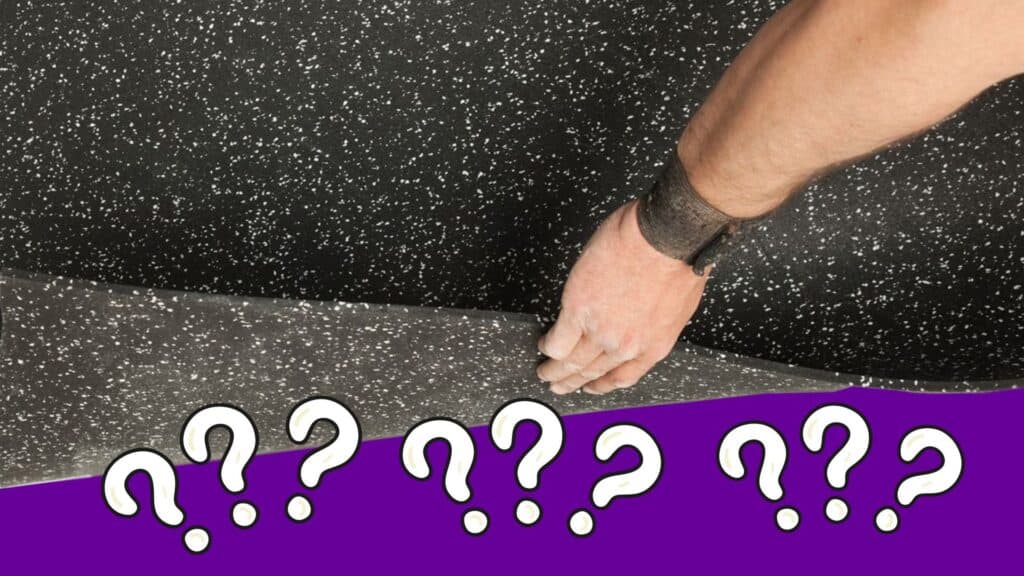Essential Layers Beneath Gym Flooring Explained (Intro)
Confused about what goes under your gym flooring? Or perhaps you’ve made the wrong choice and can’t figure out your sub-flooring needs? Knowing what to put under gym flooring is crucial as it can prolong the life span of your floor. Conversely, the wrong choice can have unwanted effects on those using your gym.
If your gym has an exposed wooden floor, there is a good chance it could lose its load-bearing capacity. In this regard, the correct installation of subflooring will protect against damage and improve its integrity. Before spending any money, ensure that the product you choose is the optimal pairing for your flooring surface.
What Goes Underneath Gym Flooring?
The ‘underlay’ forms the subfloor and acts as an intermediary between the flooring surface and the base floor. Your choice of underlay will depend on the type of base floor in your premises. The main reason to use subflooring is to curb the underneath surface from damage. For example, if you have a ceramic base floor and want to lay rubber flooring over it, the subflooring material will act as a buffer. Therefore, installing a protective layer underneath the rubber floor will protect your ceramic tiles so that they won’t break or crack.
Similarly, for a hardwood base floor, subflooring should be installed in the same manner. In this scenario, craft paper is a surprising solution. If the rubber mats are black then they can stain the hardwood over time when liquid seeps through. The rubber can also react with the wood finish, therefore having a thin paper layer will protect against this case.
An underlay for a concrete base floor is pretty different from that used for ceramic tiles. Let’s look at the appropriate underlay(subfloor) for different base floor types.

Ceramic Tiles
These are more fragile and won’t withstand the impacts of dropped weights and other gym activities. In this case, it’s best to cover the base floor with an underlay before installing a flooring surface material, such as rubber tiling. This will cushion impact and protect the ceramic tiles.
Concrete
Concrete is the most commonly found base floor material. Although far more durable than ceramic tiles, it still requires a subfloor. A go-to underlay is a full-spread adhesive. Concrete floors face moisture problems more than impact problems. The primary function of underlay is to prevent the movement of moisture into and out of your gym floor.
Hardwood
Although declining in popularity, it is still fairly common to find hardwood as a base floor material. What’s the solution? Use craft paper as an underlay. The hardwood floor may be resistant to moisture or not suffer much from impacts, but it’s prone to staining from black rubber. If you want to retain the beauty of your hardwood base floor for the future, craft paper underlay is the best solution.
Subflooring for Different Base Surfaces
Rubber underlay for concrete
Installing a rubber subfloor is a great option for concrete base floors. Installed to provide consistency and flatness to the concrete surface, it provides a long-lasting foundation which ensures the durability of a gym flooring surface. The only thing to consider is the level of moisture it can retain, as it tends to absorb ambient moisture.
Solution
You may need to have a full-spread adhesive along with this sub-flooring. This will ultimately assume the role of a water-proofing material, protecting your base floor and your gym floor from damage.
This also acts as a glue for the subflooring, preventing it from shifting and moving underfoot, potentially preventing injuries.
Padded underlay for ceramic tile
Rubber gym flooring is perfect for use over ceramic tile as it negates impact. You will, however, need sub-flooring in this instance. Sometimes the best quality ceramic tile can be weak if subjected to heavy foot traffic and weight-dropping impacts. The thicker the flooring, the less prone the ceramic tile will be to breakage.
Solution
Use padding underlay to protect the tile from damage.
Craft paper underlay for hardwood
Hardwood looks stylish and attractive. It suits the office and the home. However, in a gym, it will need to be covered. Rubber flooring is the best option, but there is one precaution: rubber flooring over hardwood requires a protective paper underlayment. This is especially necessary if your hardwood is of high quality and may be re-exposed for a different purpose in the future.
Solution
If you are using rubber flooring products, the widely suggested subflooring solution is an underlayment of craft paper. The purpose of this is to protect the hardwood from staining. The craft paper layer will absorb and prevent colour from seeping into the hardwood base floor. Therefore, if you decide to remove the rubber flooring, you will find a well-maintained surface underneath.
While rubber flooring is suitable for use indoors, it isn’t ideal for covering outdoor wooden decks. If you want to protect a wooden deck, using a modular perforated tile is the best option as it allows the drainage of any water that accumulates underneath.
Interlocking tile underlay for carpet
If you have a carpet base floor, laying rubber mats directly on top won’t work. They will move around and bunch up the carpet material, causing an uneven surface. The rubber can also cause damage to your carpet, adding further costs down the line.
Solution
Use interlocking vinyl tiles as a subflooring material that will give grip to both the carpet and the surface material. As these tiles are made of harder plastic, there will be less chance of bunching problems. The best option is to use 10 mm – 15mm thick PVC tiles over the carpet.
Sterling Tile underlay for rooftops
Outdoor rooftop spaces are a popular environment for a gym. To avoid problems, you need to have efficient drainage. Not only to allow evaporation but also to prevent mould from growing. Therefore, if you need a suitable surface for your rooftop gym, 2-inch-thick Sterling Roof Top Tiles will be the best fit. They enable rapid drainage and provide an added layer of impact protection.
Durability for Gym Flooring and Base Floor
Several factors contribute to the life span of your gym floor, including shock-absorption capability, the interaction between the gym floor and the base floor, activities in the gym, movement of machinery, etc. These all produce shocks that the floor, as a whole, must absorb. The cushioning role of the subfloor (or underlay) protects both the gym flooring surface and the base floor.
There is also the case of moisture seeping from the ground, which can destroy gym flooring. Without a subfloor or underlay the gym floor will interact negatively with moisture, and as a result, will begin to display mould growth, cracks, and damp symptoms. The wider consequences include regular repairs or even a costly full refit.
Noise Reduction
Gyms can be noisy places. Imagine people dropping weights, and the sounds they make when hitting the floor. This can become a huge turnoff for your members. An underlay, with an appropriate flooring surface, can drastically reduce unwanted noise.
Summary
Subflooring is as necessary as gym flooring itself. The use of an underlay can enhance the quality of your gym floor as a whole, and improve the overall gym experience for your members. Familiarise yourself with the type of base floor your premises contain, and use the appropriate underlay for the best results. From flat concrete floors to outdoor decks, there are many subflooring options available to best suit your requirements.
To comment on the article, please proceed to the Telegram post. We encourage you to read our comprehensive article “How To Choose Gym Flooring“.
Disclaimer: The opinions and positions expressed in this publication are those of the authors and collaborators and do not necessarily reflect the views or policies of the professional fitness community.

